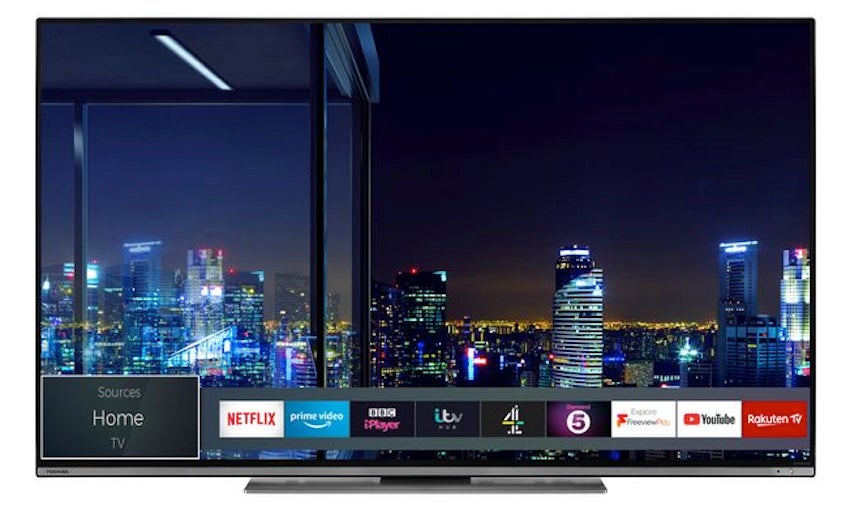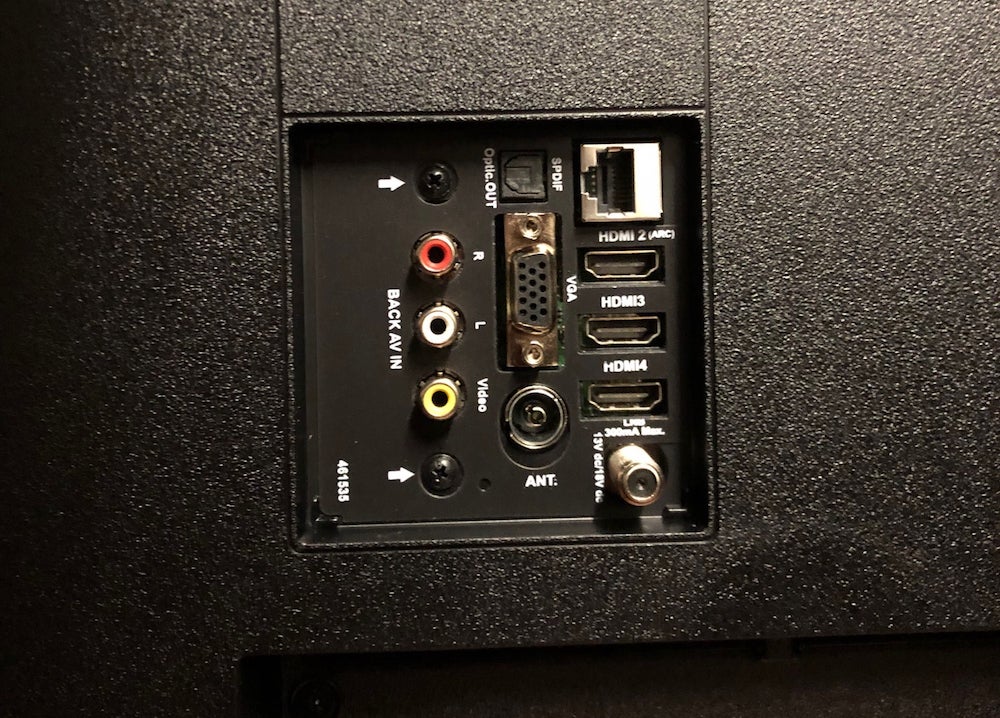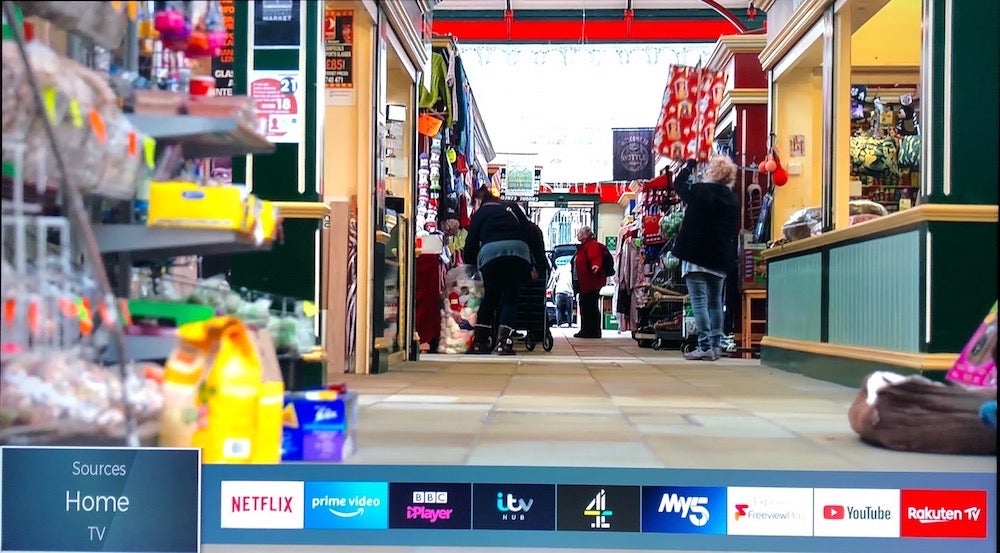What is the Toshiba 55UL7A63DB?
The Toshiba 55UL7A63DB is a 55-inch 4K TV costing less than £500. That’s enough in itself to grab the attention of any TV bargain hunter – but it’s just the start of its attractions.
It also carries a pretty respectable smart TV system, complete with Alexa voice control. It supports not just high dynamic range, but the premium Dolby Vision HDR format, too.
Related: Toshiba launches brand new 2019 TVs with Dolby Vision HDR support
Toshiba 55UL7A63DB design and build quality — A surprisingly attractive TV for such an affordable set
The Toshiba 55UL7A63DB looks surprisingly attractive for such a cheap TV – at least from a distance. Particularly striking is the slimness of both its screen frame and rear, which give it quite a premium appearance.

Up-close you start to notice that Toshiba has chosen to go pretty heavy on the plastic. However, this isn’t especially visible from a typical viewing distance, and while the screen is pretty lightweight, the desktop plinth it attaches to is a startlingly heavy slab of metal.
The 55UL7A63DB ships with an external Alexa listening device that connects to the TV via a USB cable – not exactly as tidy as having voice-recognition built into the remote control. Nevertheless, the audio receiver is at least small and easy to hide, plus you don’t get voice-recognition at all on most budget TVs.
Surprisingly for its price, the Toshiba 55UL7A63DB ships with two remote controls. Both are quite well designed, with decent button layouts and handy direct access to key video-streaming services. One odd difference, though, finds the full-sized remote carrying a direct access button for Amazon Prime Video, while the smaller, less button-heavy remote swaps the Amazon Prime Video remote for a Rakuten one. Personally, I’d have preferred an Amazon button on both.
Related: Best TVs 2019
Toshiba 55UL7A63DB features — A strong selection of features at this price point
The Toshiba 55UL7A63DB’s £479 price is arguably its single most important feature. It still sits towards the top of Toshiba’s latest UK range, despite its affordability, but it boasts a few other features you wouldn’t expect for so little money.

For instance, as well as handling the industry standard HDR10 system, the 55UL7A63DB can also play the broadcast-friendly HLG system (as used by the BBC iPlayer app for both live and catch-up HDR streams) and Dolby Vision. This provides extra scene-by-scene picture information to help TVs deliver better HDR pictures.
While smart features are starting to appear on almost all TVs these days, the Toshiba 55UL7A63DB carries a better selection than you’d expect for its price. In fact, there are dozens of apps presented through a surprisingly sleek and economical GUI.
As usual, though, most UK users will only really care about a few: Netflix, YouTube, Amazon Prime Video, Freeview Play (which hosts the catch-up services for the UK’s main terrestrial broadcasters), and Rakuten.
Related: Dolby Vision HDR – everything you need to know
The Toshiba 55UL7A63DB supports 4K and HDR streams on Netflix, Amazon Prime and YouTube. And that HDR support includes Dolby Vision if a streamed show is offered in it.
The 55UL7A63DB claims to be using micro-dimming technology in its LCD panel. This sounds exciting, as the micro dimming term is now typically associated with TVs that use direct LED lighting and a huge number of small local dimming zones. However, it turns out that this isn’t what Toshiba means my micro-dimming.
Despite its acute slimness, the 55UL7A63DB does use a direct LED lighting system, where the lights sit right behind the screen rather than around its edges. But there’s no system for having different zones of these lights simultaneously output different light levels to boost contrast.

In fact, it’s hard to work out exactly what Toshiba’s Tru Micro Dimming feature does. Not least because trying the feature’s different settings seems to make very little difference to the picture. Surprisingly for its price, the Toshiba 55UL7A63DB provides both a motion processing system and some relatively in-depth picture calibration tools, including white point and colour balance tweaks. This is impressively ambitious for such an affordable 55-inch TV.
Connectivity, too, is strong for the outlay. For starters, it boasts four HDMIs, two USBs and, unusually for today’s TV market, both genuine component video and VGA PC inputs.
Actually, these latter two connections kind of make you wonder if the TV is using a particularly up-to-date chassis. Perhaps I’m being too suspicious here. Maybe the current owner of the Toshiba brand in the UK, Turkish manufacturer Vestel, just wants to ensure that legacy equipment is supported – and there’s absolutely nothing wrong with that.
Toshiba 55UL7A63DB setup — Tricky to get the best picture, with a sluggish interface
While the Toshiba 55UL7A63DB’s menus are nicely presented and laid out, they can run frustratingly sluggishly at times.

Picture presets offer plenty of picture variety, but all come with a string or two attached. For instance, the Dynamic preset gives the best shadow detailing, especially with HDR, but it also results in noise and some strained-looking colours.
The Cinema preset does the best job of suppressing some backlight clouding, but it also takes too much brightness out of dark areas, leaving them looking hollow. It can also cause bright HDR areas to look flared out.
The default Natural picture preset probably offers the most all-round balance – especially if you set Dynamic Contrast to Low. Higher Dynamic Contrast settings again cause elevated levels of noise.
Toshiba’s Tru Motion processor isn’t bad at all for such an affordable TV. It reduces judder without resulting in too processed or unnatural-looking pictures. Purists will be pleased to hear that the 55UL7A63DB’s native motion handling without Tru Motion active is also pretty good.
Related: Best smart TV

Make sure you turn off NR for all 4K and good-quality HD sources, since it can make them look unnecessarily soft.
Use the “Smart” Dolby Audio setting to stop the sound appearing muffled, and make sure you switch to Game mode if you’re video gaming, since this reduces the TV’s response time to a respectable –although not spectacular – 28ms.
One last point to stress is that if you end up with a Toshiba 55UL7A63DB, try to feed it as much Dolby Vision content as you can.
Toshiba 55UL7A63DB performance — Not the brightest of TVs for true HDR performance
The Toshiba 55UL7A63DB’s pictures are serviceable enough for such an affordable TV, but don’t expect budget miracles.
Let’s get the bad news out of the way first. Starting with its lack of brightness. I measured the Toshiba 55UL7A63DB’s peak light output when using a white HDR square over 10% of the screen at just 288 nits in the brightest Dynamic mode. This drops to 250 nits in Cinema mode.
These figures do at least remain stable; you don’t get the extreme but short-lived bursts of brightness some high-end rival TVs use to achieve brightness peaks as high as 2000 nits or more. However, the reality is that to do HDR properly you need brightness, and 288 nits isn’t enough to deliver a truly convincing HDR experience.
Related: What is HDR?

What’s more, you can’t even really use the 55UL7A63DB’s maximum brightness because this can cause substantial “clipping” (detail loss) in the brightest parts of HDR pictures. At the same time, though, if you reduce brightness to combat the clipping then you can lose subtle detail in dark areas, leaving them looking flat and empty.
In other words, the band of effective brightness you can use on the Toshiba 55UL7A63DB is pretty narrow. As well as this band not really being bright enough to deliver much of an HDR experience, it’s impossible to settle on a magical combination of settings that simultaneously tackles the TV’s shadow detail and clipping problems. There’s always a trade-off in one area or the other.
Another significant issue with the 55UL7A63DB’s pictures is backlight clouding. This can appear in numerous places over dark shots. It’s clear enough, even in the most contrast-rich Cinema mode, sometimes making you feel like you’re watching the darkest scenes through some sort of cloud filter.
It’s important to stress at this point that the sort of brightness and backlight issues the Toshiba 55UL7A63DB has with HDR are extremely common with affordable TVs. In fact, many suffer with them far worse – as well as delivering shallower black levels than the 55UL7A63DB does. In fact, the 55UL7A63DB’s susceptibility to areas of clouding is partly because it’s capable of hitting black levels slightly deeper than those of many budget TVs.

The Toshiba 55UL7A63DB does a respectable job with colour for its money – provided you’ve already done as suggested earlier and reined in the TV’s already limited brightness. If you don’t, the screen’s relatively limited colour gamut by HDR TV standards can leave tones with HDR content looking washed out. Dark colour tones start to look a little rough and ready with the brightness too high, too.
Again, you’re essentially neutering the HDR and wide colour experience to achieve the most natural results. But really you’re just working with what this particular TV can give you, and the results are much more enjoyable than trying to push HDR to places this TV can’t go.
Crucially, the Toshiba 55UL7A63DB has one secret HDR colour and contrast weapon up its sleeve: its Dolby Vision support. Feeding in Dolby Vision sources makes a huge difference to picture quality, boosting contrast and especially enhancing colour tones. The extent of the difference Dolby Vision confirms that Dolby’s system actually has its biggest effect on affordable screens.
Of course, not everything you watch is available in Dolby Vision. In fact, only a minority of 4K Blu-ray discs and streams support it. But at least the 55UL7A63DB is ready and able to benefit from its picture boost when and where you can access it, whereas most similarly priced TVs are not.
The Toshiba 55UL7A63DB does a decent job of selling its native 4K resolution. With relatively static 4K shots you can clearly see more texture and detail than you’d get with a mere HD TV. What’s more, the set doesn’t lose as much of that detail during motion as you might have expected.
Judder can occasionally be slightly distracting, while the Tru Motion system can create some gentle smearing if you use that to tackle the judder. There’s a tendency, too, for areas of heavily contrasting fine detail to flicker a little. But none of these issues is disastrous for such an affordable TV, especially if you avoid the noise exaggerating Dynamic picture setting.
The Toshiba 55UL7A63D also does a respectable job of converting sub-4K sources to 4K, better than many of its similarly priced rivals. It’s especially good for its money at removing noise from sub-4K sources before upscaling them. Even very grainy HD source images typically end up looking polished and believable.

Some skin tones can become a touch plasticky post upscaling. However, when that’s the only upscaling problem you have on such an affordable TV, you’re in pretty strong territory.
As with all budget TVs, the Toshiba 55UL7A63D is happier as an SDR display than an HDR one. It delivers a quite natural SDR image, with good contrast and reasonably authentic, nuanced colours (since SDR colours sit within the screen’s lighting and colour gamut comfort zone more comfortably).
So much more effective is the 55UL7A63D with SDR video. In fact, I’d seriously consider running 4K HDR games consoles in SDR mode, and getting a Panasonic 4K Blu-ray player that lets you convert HDR discs to SDR, so that you can enjoy the TV’s 4K resolution without having to stress it out with HDR.
The Toshiba 55UL7A63D’s audio performance is about par for the budget TV course. Which is to say that it isn’t really up to much. This is despite the fact that usually strong audio brand Onkyo has apparently had a hand in the sound system’s development. Its speakers lack projection and dynamic range, leading to a rather compressed and muffled sound. The tone also tends towards boomy, sounding like it’s coming from inside a box, and can become quite harsh during dense moments.
Bass is present, to be fair, but it sounds rather dislocated from the rest of the sound. Similarly, the set can go quite loud without causing cabinet rattle or speaker phutting, but the compressed nature of the sound means that it isn’t a particularly pleasant loud experience.
The Toshiba 55UL7A63D does distinguish itself from budget rivals with a relatively direct, front and forward tone, however. In addition, its helpful Dolby Audio modes reduce the muffling effect and make voices – especially male voices – sound more convincing than they often do on budget TVs.
Related: Best Soundbars 2019
Should I buy the Toshiba 55UL7A63DB?
Inevitably, given how cheap it is, the Toshiba 55UL7A63D is far from perfect. It isn’t really bright enough to do HDR properly, and it’s hard to find a perfect brightness level that preserves shadow detail without causing backlight clouding and elevated noise. You’ll probably end up wanting to partner it with some sort of external audio system at some point, too.
Its Dolby Vision support really helps its HDR efforts, though, and it’s a more than solid SDR performer.
Don’t forget, too, that most of the Toshiba 55UL7A63DB’s issues also apply to other budget TVs. And, actually, the 55UL7A63DB does get some things right that many budget rivals don’t. Its smart system is both content rich and neatly presented, for instance. The Alexa voice control support is unusual, too, as are its reasonable black levels. Colours can look good as well, so long as you don’t try to make HDR too bright.
The most promising challenger to the 55UL7A63D, if you can find £70 more, is the Philips 55PUS6754. This just-released sequel to the impressive 55PUS6753 boasts support for both the Dolby Vision and HDR10+ “dynamic HDR” formats, and Philips’ unique Ambilight technology.
Verdict
Provided you can accept/work around its (all too typical) budget TV HDR and backlighting limitations, the Toshiba 55UL7A63DB has a decent amount to offer for its eye-catching £479 price tag.
The post Toshiba 55UL7A63DB appeared first on Trusted Reviews.
EmoticonEmoticon